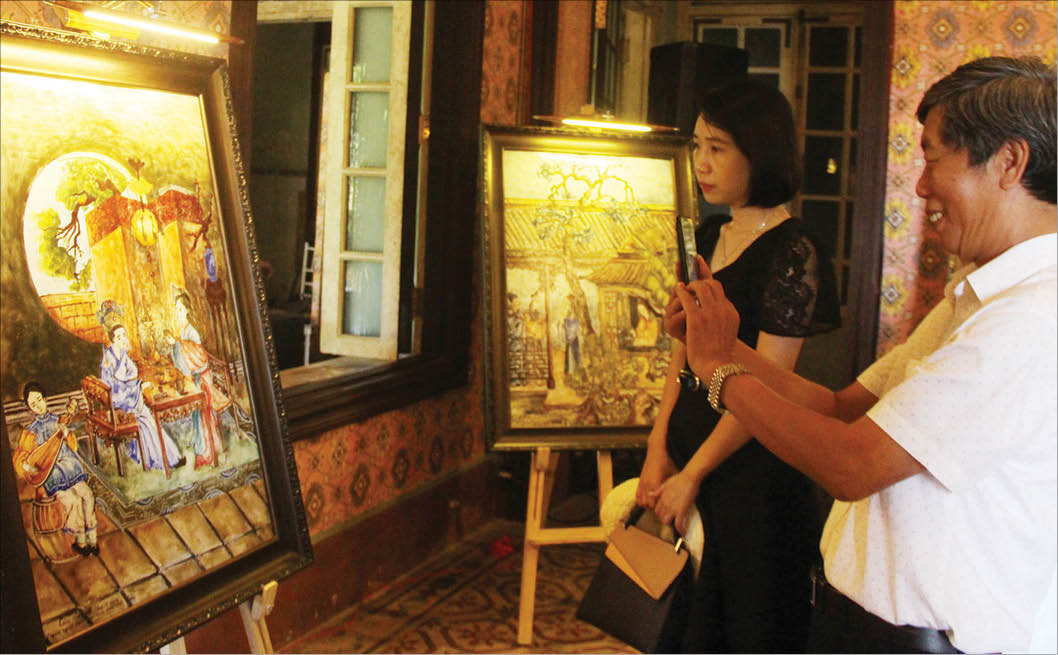
The set of 20 phap lam paintings depicting Kieu catches many people’s attention
The idea was born at a reunion of friends who love Hue from Ho Chi Minh City. Soon after that, they flew to Hue to meet up with Do Huu Triet and his partners at Phap Lam Hue Co. Ltd. to materialize their idea.
The only paintings
As said by Triet, he was a bit hesitant at first, but then he and his partners decided to give it a try. The 20 paintings were completed at the same time by various painters.
“Though there were many obstacles, it was the idea of combining phap lam as a technology with art that interested us,” said Triet. After many months, the set of paintings were completed.
The set comprises 20 paintings based on the illustrative paintings about Kieu by Manh Hung from the book Thuy Kieu Tale published by the Ngo Tu Ha publishing house in 1925 in Hanoi. Each painting is accompanied with some lines from Thuy Kieu Tale. The phap lam paintings remain loyal to the ones in the book in terms of layout and style, but typical colors of phap lam are added.
The paintings on display prove that phap lam is not confined to decoration but can be used as a material for painting. Especially, this set is the only paintings of this type in Vietnam.
Making this set of paintings was not a bed of roses. Phap lam had been for a long time extinct. Not until 2000 did Do Huu Triet and his partners take pains to revive this unique art. Their success was highly valued by researchers.
Thanks to its special making, phap lam is not only beautiful in form but also durable against collision or corrosion by the environment. In the Nguyen’s era, Vietnamese artisans learnt phap lam from China then made it into phap lam Hue. Phap lam developed strongly in Minh Mang’s, Thieu Tri’s, and Tu Duc’s eras. It began to decrease in Dong Khanh’s era then became extinct.
Daring
Many experts and researchers came to see the paintings on display at the An Dinh palace. They stopped at each painting; all admired them for their liveliness and sophistication. They talked about phap lam and how it had been preserved as a traditional craft and brought farther to different places.
The researcher Nguyen Huu Thong briefly told everyone at the exhibition that the revival of phap lam Hue had left a great impression on him and it deserved the top place among the leading achievements of lost traditional craft restoration. With these phap lam paintings, a new horizon is opened up for phap lam Hue.

According to Thong, in the past, being the imperial capital of the Nguyen dynasty, Hue gathered talented workers from all over the country. They produced many sophisticated products representing the art of Vietnam including phap lam. It can be seen now through household objects and the interior and exterior designing and worship objects at royal palaces and mausoleums.
However, when the Nguyen dynasty declined, phap lam works gradually disappeared and phap lam became extinct. “That’s why the revival of phap lam impressed me. It was a huge success,” stressed Nguyen Huu Thong.
Assoc. Prof. Dr. Phan Thanh Binh, an expert on fine arts, had the same idea and said that the launch of the Kieu paintings of phap lam Hue is an extremely daring event. They prove artisans’ capability of renewing phap lam Hue and making it attractive.
“In my opinion, this has been much progress. These paintings prove phap lam Hue is not confined to historical relics only but can be treated as an independent form of art,” praised Phan Thanh Binh. He believes that there will be more achievements in reviving Hue traditional crafts in general and phap lam in particular.
Story and photos: Nhat Minh